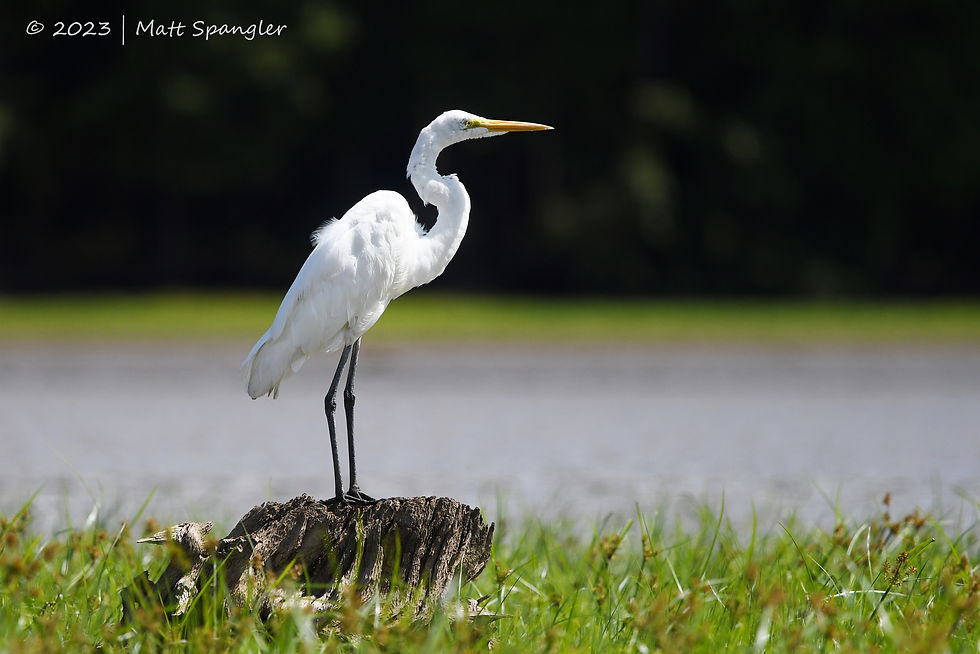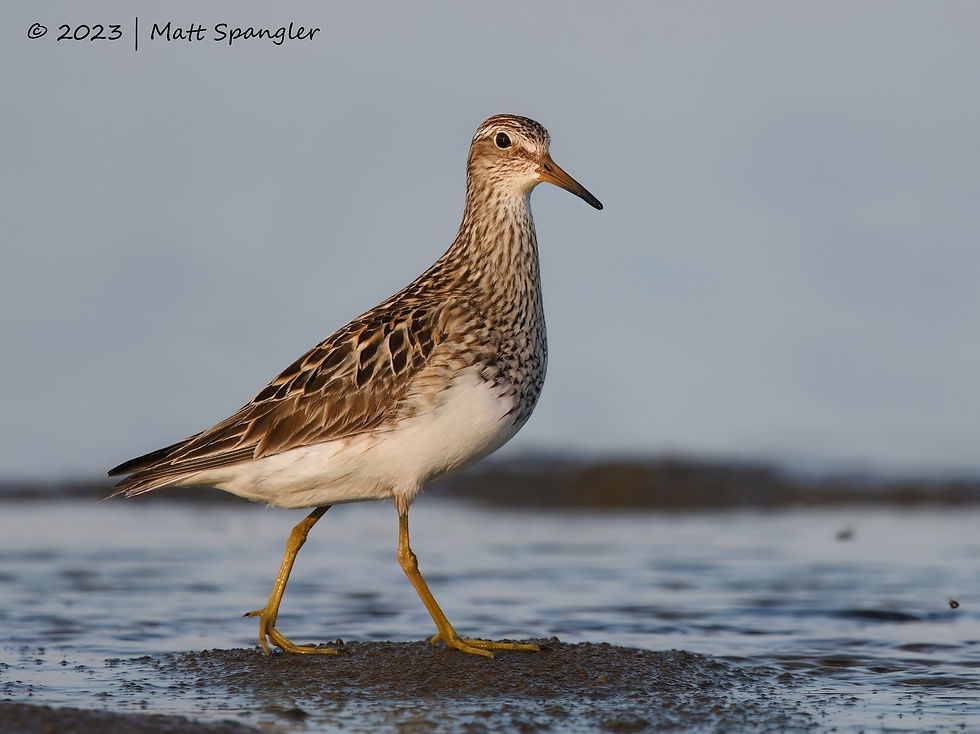Jordan Lake Waders, Shorebirds, & Ducks #9 (2023)
- Matt Spangler
- Oct 14, 2023
- 6 min read
Updated: Nov 24, 2023
My 9th year birding the Jordan Lake mudflats was undoubtedly the most exciting yet. Lake levels were the lowest (read: best) since 2017, and a constant procession of rare birds kept things interesting. Waders, shorebirds, and ducks are among my favorite birds, and it’s always nice to see so many predominantly coastal species in the piedmont this time of year.

Lake Levels: As noted above, the drought-induced-late-summer-lake-drop this year was the best since 2017. The lake steadily declined from mid-July to late August, bottoming out at 213.5 feet above sea level (3 feet below full pond). This exposed a lot of great habitat at precisely the right time for the start of shorebird migration. The mudflat progression involved a delicate balance between plants colonizing the dryer areas (Redroot Flatsedge and other annuals like Scarlet Toothcup) and new mud emerging as the lake retreated towards the deeper creek channels.
A few storms in September caused momentary fluctuations in the water level. Although the lake never rose more than 6” at a time, it still wasn’t ideal. The water submerged all the fresh mud, leaving only sedge flats that offered fewer opportunities for foraging shorebirds.
Fortunately, the lake resumed its steady decline in October, just in time for the final push of shorebirds and the arrival of dabbling ducks. At the time of blog writing, the lake was at 212.5 feet (4 feet below normal). At this point, the larger lake arms were replaced by creeks flowing through hundreds of acres of mudflats and sedge flats. In addition to good birding, the transformation made for truly beautiful scenery, only possible once or twice a decade.
It would be cool to set up a time-lapse (maybe next year), but at least I got more landscape photos than years prior (including some interesting reflection shots while the lake still had water).
Waders: Ok, time for the birds. The wading birds dominated in July and August, tapering off by September. I saw 9 species of herons, egrets, and other not-closely-related-but-similar-shaped species. The annual Great Egret spectacle ran from July to into October, maxing out at 153+ birds this year. Little Blue Heron numbers maxed out at a respectable 37. Notable early season waders included a few Yellow-crowned Night-Herons (7/19 and 8/11 at New Hope Creek) and up to 11 White Ibises (5 occasions at New Hope,). Wood Storks also kept up their near-annual appearance, with a high count of 6 at once (9/22 at New Hope, plus 4 other occasions).

The undeniable star of the wader show was Jordan Lake’s first ever LIMPKIN—a species that I and others have been eagerly awaiting for a few years. After another birder found one at New Hope one Tuesday morning (8/22), I took a half-day and ran over to find the bird. It hadn’t been seen in a few hours, so I figured it was up the creek, out of sight. I waded across 100 yards of literally knee-deep mud to get to the opposite side of the creek, then hiked through the woods until I found the bird. This was probably the hardest I’ve ever worked to see a new state bird (#350 for my NC list).

This extraordinary effort proved unnecessary; the Limpkin stuck around until late September, and I saw it on three more occasions. Its precise location was often hard to predict, as it split its time between New Hope and Northeast Creeks, feasting on enormous invasive Giant Floater Mussels. On one kayak trip to Northeast Creek, the bird allowed me some great photo ops.
Shorebirds: Waders are great, but shorebirds are the main star of this annual blog post. And they were truly stars this year. I personally saw 22 different species of shorebirds on the lake, a new personal record (2017 was close, with 20 species).
Where to start? How about the rarest species: a Piping Plover. This endangered species is normally strictly coastal, but one turned up this year at the White Oak Creek mudflats, which I chased down on 8/29. Remarkably, a different individual was seen later in the year at Northeast Creek; I missed that one. Other rare shorebirds included American Avocet (9/1 at New Hope, and 9/2 at Morgan), American Golden-Plover (9/8, New Hope), Baird’s Sandpiper (8/22, New Hope), Buff-Breasted Sandpiper (9/14, Northeast), and Wilson’s Phalarope (8/22, New Hope).
Less rare but still exciting were large numbers of White-rumped Sandpipers (13 on 9/8 at New Hope), Stilt Sandpipers (9 on 9/16 and 9/22 at New Hope) and at least 1 Western Sandpiper (8/22, New Hope). The Piping Plover, Avocet, and Western were all new for my Chatham Co. list, bringing me to 243 species.
The mudflats also featured unusually high numbers of more common species, including 48+ Semipalmated Plovers, 48+ Pectoral Sandpipers, and 80+ Least Sandpipers.

In addition to the 22 species of shorebirds I saw, other birders saw at least three additional species I missed this year: Black-bellied Plover, Ruddy Turnstone, and Red-necked Phalarope. I made a conscious choice not to chase after those, but it was tempting!
Ducks: The first Blue-winged Teals showed up in late August, marking the start of dabbling duck migration. The teals were followed by an occasional early season Northern Shoveler. Duck numbers and diversity really picked up in October, with Green-winged Teal, American Wigeon, and Northern Pintail joining the mix. If I waited another month to write this blog, I’d undoubtedly have more ducks to talk about, but 8 species of waterfowl made for a nice early fall season.

Bonus Birds: Although waders, shorbs, and ducks are the focus of these local lake trips, they’re only a small sliver of the avian pie. I saw 119 species of birds on this year’s mudflat outings. Notable waterbirds at the flats included Anhinga (8/1 and 8/11, New Hope), American White Pelican (10/9, New Hope), and Sora (flushed at Northeast on 10/9). Raptors were constantly roaming the flats. In addition to the ever-present Bald Eagles and a variety of hawks, I saw a two Merlins (8/20 and 9/16, New Hope). It was also nice to hear both Eastern Whip-poor-wills and a Chuck-will’s-widow singing from the woods near the flats in late summer.
One of rarest animals I found the entire season was a male Roseate Skimmer, a spectacular dragonfly of the southeastern coast that very rarely strays into the NC piedmont. I know, it’s not a bird, but I make the rules here.
Summary by the Numbers
Between mid-July and mid-October, I made 16 trips to the lake (22 total surveys) in search of waders, shorebirds, and ducks. As usual, most of these were to the New Hope Creek area (12 trips, including 3 by kayak), followed by 4 trips to Northeast Creek (2 by kayak), 3 to Overcup Creek, 1 to Morgan Creek, 1 to White Oak Creek; and 1 around the Fearrington Road causeway area (by kayak). As usual, most of the pics in this blog were achieved from my kayak.
I joined other birders on 1/3 of the trips—sometimes intentionally, other times by coincidence. Ever-increasing numbers of talented local birders has pros and cons. The upside: increased coverage means more good birds are found and reported. The downside: this can give rise to serious FOMO. Also, it’s just more fun to find birds on my own, rather than chasing birds found by others. Alas, gone are the days when I’d discover the best birds on the mudflats.
Here’s a full breakdown of the 9 species of waders, 22 species of shorebirds, and 8 species of ducks I saw on the lake this summer/fall:
Postscript (11/17/23 update)
The main part of this blog details main-season mudflats birding, through mid-October. My travel calendar prevented me from birding locally in the weeks that followed, but the lake kept dropping and the birds kept coming. So, I made one last visit on 11/17, and saw enough good birds to justify updating this blog. By mid-November, the lake hit 211.8 feet (about 5 feet below full pond; lower than I've ever seen it). This meant hundreds of acres of mudflats. The birds were widely scattered, and finding them required a long hike through the mud. But it was worth it.
Of the 9 species of shorebirds present, the best was a Piping Plover (which I finally found for myself, instead of chasing others' sightings)! Two continuing Black-bellied Plovers and an American Golden-Plover were also great, bringing my shorebird count up to 23 species. A few dozen Dunlin were also present; they're dependable in large numbers if the mudflats stick around long enough. A Pectoral Sandpiper was running decidedly late on its journey to its wintering grounds. Shorebirds are cool, but the best bird of the day was a Horned Lark (a long-awaited new bird for my Chatham Co. list, now at 246 species).
Most of my local birding energy has shifted to ducks on the main lake body, so I may call it quits on the mudflats blog for this year. However, the lake will likely stay ultra-low well into December, so I'm not ruling out the possibility of one more update to this blog.



















































































































